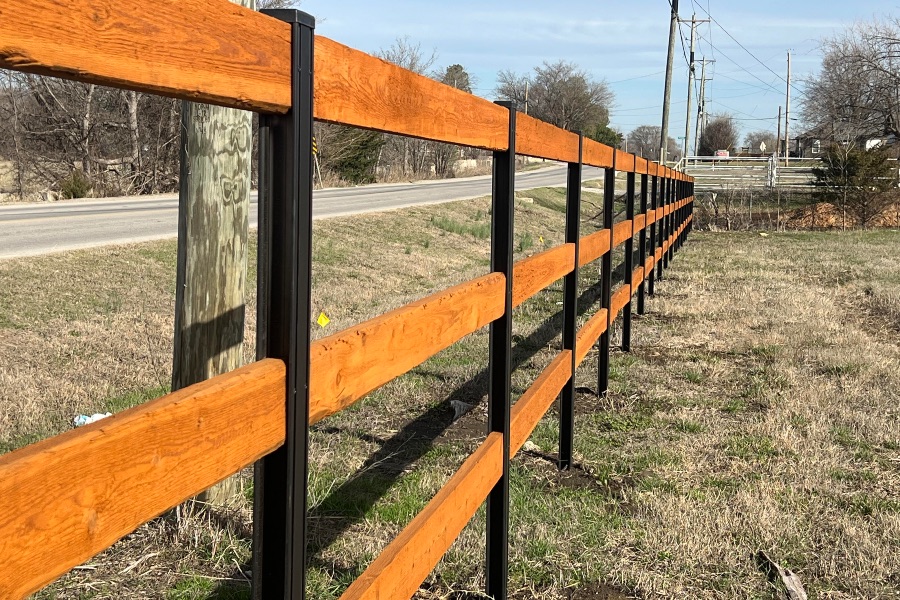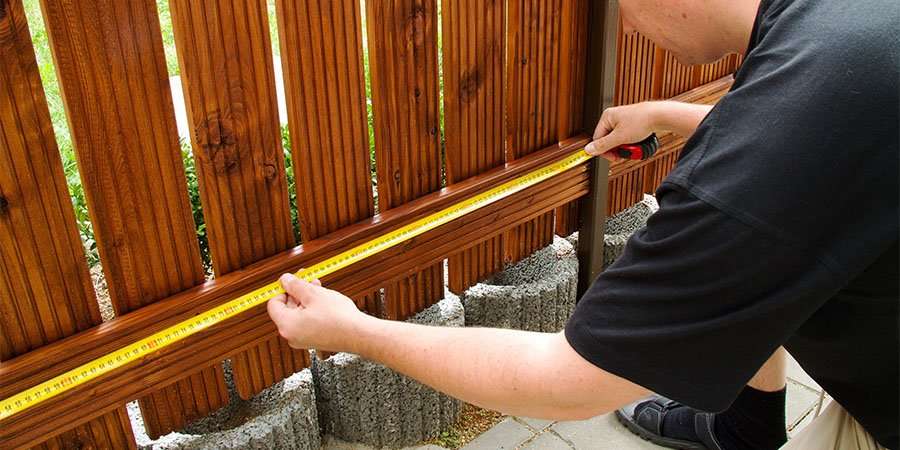All Categories
Featured
A properly chosen fencing can act as an effective deterrent against invaders and enhance the general security of your home or company. Choosing the right elevation involves several variables, including regional policies, your specific safety and security requirements, and the kind of fencing you are thinking about.
![]()
In many cases, house owners might need a permit to construct a fencing over a certain elevation. To stay clear of legal issues or penalties, constantly get in touch with your neighborhood authorities before waging installment. Additionally, if you live in a neighborhood governed by a property owners' organization (HOA), make certain to evaluate their standards, as they may have certain guidelines regarding fence height and layout.
In more high-risk areas, or if you have beneficial home or are taking care of safety and security issues, you might intend to think about an also taller fence-- approximately 8 feet or greater. A taller fence is more frightening to possible trespassers and uses a much better physical obstacle. If you want to go even additionally, consider including protection attributes like razor cord, electrical fencing, or sharp latticework tops, which can make the fence a lot more difficult to violation.
Wooden Fencings: Wood fencings give privacy, however they can be relatively easy to climb. An elevation of 6 to 8 feet is suggested for appropriate protection. To enhance deterrence, think about adding pointed tops or mounting a trellis with climbing plants. Wrought Iron Fencings: Wrought iron fencings are sturdy and hard to climb. They're typically utilized for higher-security functions and can be developed in between 6 to 8 feet tall. The upright bars, specifically when topped with spikes or points, work as a powerful barrier. Chain-Link Fences: A chain-link fencing that's 6 to 8 feet high can give a cost-effective and useful remedy. Including attributes like barbed cable or razor cord on top can increase protection considerably. Vinyl Fencings: Vinyl fencings can likewise offer privacy and safety and security, however like wood fencings, they may need additional elevation and includes to protect against climbing. A strong vinyl fencing of 6 to 8 feet in height can be extremely effective at keeping undesirable visitors out. 4. Privacy vs. Security. If your key issue is personal privacy, a taller, solid fence (like wood or vinyl) may be the finest option. Taller fencings obstruct the sight from the outdoors, making sure that burglars can not quickly analyze your building or place belongings. Privacy fences of 6 to 8 feet are common for this function.
However, if safety is even more of a worry than privacy, you could wish to opt for a fence product that offers exposure, such as chain-link, while still being tall sufficient to deter climbing up. The benefit of this method is that it allows you to maintain an eye on activity outside your property and make it more challenging for a person to method undetected.
![]()
Anti-Climb Attributes: Installing anti-climb spikes or trellis extensions at the top of your fence will make it a lot more hard for burglars to scale it. These can be specifically reliable on wood or plastic fencings. Razor Cable or Barbed Cable: If safety and security is a significant worry, including razor cable or barbed cord to the top of your fencing is a very reliable deterrent. These attributes can be incorporated with a strong wood or chain-link fencing for optimum security. Electric Fencing: For enhanced safety, electric fence can be mounted on top of an existing fencing. While these require special setup and an expert to ensure security, they can be extremely efficient in avoiding unapproved access to your residential property. 6. Visual Factors to consider. While safety is the key goal, it's likewise essential to consider just how the fencing will look. Some communities or communities might have aesthetic criteria or HOA standards, so choosing a fence that matches your property's design while still offering safety and security is crucial. Choosing a fencing that mixes right into the setting and fits the architectural design of your home can make certain that your fence is both visually attractive and functional.
Verdict. When picking a fence elevation for optimal security, go for a balance between elevation, material, and extra security functions to best meet your requirements. A height of 6 to 8 feet is typically adequate for a lot of houses, however if you stay in a high-risk location or have certain safety issues, taller fencings with added functions like spikes or electrical systems could be essential. Don't forget to examine neighborhood policies and HOA policies to ensure your fencing follows community guidelines. By considering these factors, you can pick a fence height that boosts both the safety and security and visual value of your residential property.
- Understand Local Regulations and Rules. Before you spend in a new fencing, it's necessary to recognize the regional zoning regulations and building codes that may determine the maximum height for surround your location. Several districts have limitations on the height of fences, especially for front yards, where fencings are often restricted to 3 to 4 feet. In yards, nonetheless, you may be enabled to construct taller fences, normally ranging from 6 to 8 feet.

In many cases, house owners might need a permit to construct a fencing over a certain elevation. To stay clear of legal issues or penalties, constantly get in touch with your neighborhood authorities before waging installment. Additionally, if you live in a neighborhood governed by a property owners' organization (HOA), make certain to evaluate their standards, as they may have certain guidelines regarding fence height and layout.
- Take into consideration the Level of Security You Need. The height of your fencing directly associates with the degree of safety and security it supplies. A fencing that's as well brief might be easy to climb up over or bypass, making it inefficient in staying out burglars. For higher safety and security, go for a fence height of a minimum of 6 feet, which is commonly adequate to avoid most people from conveniently scaling it.
In more high-risk areas, or if you have beneficial home or are taking care of safety and security issues, you might intend to think about an also taller fence-- approximately 8 feet or greater. A taller fence is more frightening to possible trespassers and uses a much better physical obstacle. If you want to go even additionally, consider including protection attributes like razor cord, electrical fencing, or sharp latticework tops, which can make the fence a lot more difficult to violation.
- Pick the Right Fence Product. Various fencing products provide varying degrees of safety, and the height of the fence need to be matched with the material's toughness. :
Wooden Fencings: Wood fencings give privacy, however they can be relatively easy to climb. An elevation of 6 to 8 feet is suggested for appropriate protection. To enhance deterrence, think about adding pointed tops or mounting a trellis with climbing plants. Wrought Iron Fencings: Wrought iron fencings are sturdy and hard to climb. They're typically utilized for higher-security functions and can be developed in between 6 to 8 feet tall. The upright bars, specifically when topped with spikes or points, work as a powerful barrier. Chain-Link Fences: A chain-link fencing that's 6 to 8 feet high can give a cost-effective and useful remedy. Including attributes like barbed cable or razor cord on top can increase protection considerably. Vinyl Fencings: Vinyl fencings can likewise offer privacy and safety and security, however like wood fencings, they may need additional elevation and includes to protect against climbing. A strong vinyl fencing of 6 to 8 feet in height can be extremely effective at keeping undesirable visitors out. 4. Privacy vs. Security. If your key issue is personal privacy, a taller, solid fence (like wood or vinyl) may be the finest option. Taller fencings obstruct the sight from the outdoors, making sure that burglars can not quickly analyze your building or place belongings. Privacy fences of 6 to 8 feet are common for this function.
However, if safety is even more of a worry than privacy, you could wish to opt for a fence product that offers exposure, such as chain-link, while still being tall sufficient to deter climbing up. The benefit of this method is that it allows you to maintain an eye on activity outside your property and make it more challenging for a person to method undetected.
- Enhancing the Protection with Additional Functions. The elevation of your fencing is only one aspect of your total safety technique. Take into consideration including added features to boost its effectiveness:

Anti-Climb Attributes: Installing anti-climb spikes or trellis extensions at the top of your fence will make it a lot more hard for burglars to scale it. These can be specifically reliable on wood or plastic fencings. Razor Cable or Barbed Cable: If safety and security is a significant worry, including razor cable or barbed cord to the top of your fencing is a very reliable deterrent. These attributes can be incorporated with a strong wood or chain-link fencing for optimum security. Electric Fencing: For enhanced safety, electric fence can be mounted on top of an existing fencing. While these require special setup and an expert to ensure security, they can be extremely efficient in avoiding unapproved access to your residential property. 6. Visual Factors to consider. While safety is the key goal, it's likewise essential to consider just how the fencing will look. Some communities or communities might have aesthetic criteria or HOA standards, so choosing a fence that matches your property's design while still offering safety and security is crucial. Choosing a fencing that mixes right into the setting and fits the architectural design of your home can make certain that your fence is both visually attractive and functional.
Verdict. When picking a fence elevation for optimal security, go for a balance between elevation, material, and extra security functions to best meet your requirements. A height of 6 to 8 feet is typically adequate for a lot of houses, however if you stay in a high-risk location or have certain safety issues, taller fencings with added functions like spikes or electrical systems could be essential. Don't forget to examine neighborhood policies and HOA policies to ensure your fencing follows community guidelines. By considering these factors, you can pick a fence height that boosts both the safety and security and visual value of your residential property.
Latest Posts
Find Best Vehicle Maintenance Care at Montclare Auto Repair – Expert Care for Your Vehicle
Published en
1 min read
How to Know When Your Car Needs Expert Car Repair at Montclare Auto Repair
Published en
1 min read
Recognizing Roofing Service Warranties: What Homeowners Need To Know
Published en
1 min read
More
Latest Posts
Find Best Vehicle Maintenance Care at Montclare Auto Repair – Expert Care for Your Vehicle
Published May 25, 25
1 min read
How to Know When Your Car Needs Expert Car Repair at Montclare Auto Repair
Published May 24, 25
1 min read
Recognizing Roofing Service Warranties: What Homeowners Need To Know
Published May 23, 25
1 min read